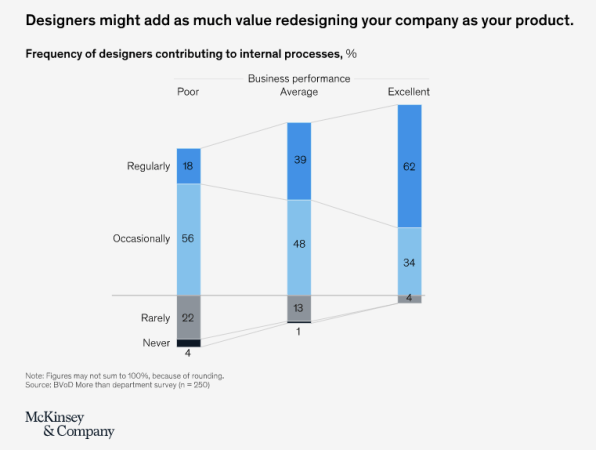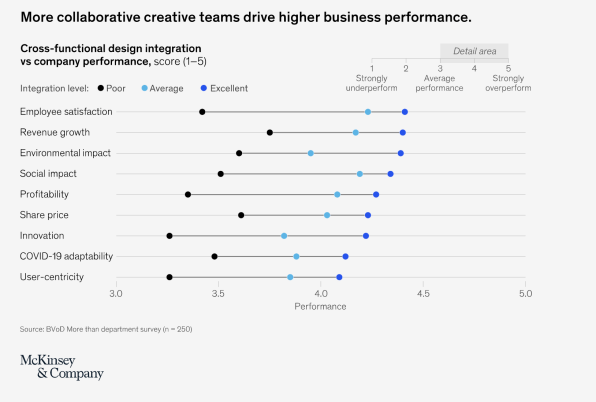- | 12:00 pm
McKinsey report: Designers are critical to business performance, but there’s a big catch
A massive McKinsey analysis of 3 million designers and 100,000 design departments reveals some surprising insights into how businesses should leverage their design department.

The business community has long understood that a healthy design team is critical to a healthy business—and research suggests that companies with strong design investment can grow revenue at twice the rate of industry peers.
But why do some design teams succeed where others fail? Global consultancy McKinsey & Co. attempts to answer the question in a a major new report that provides insight into why some design teams tend to make a bigger impact inside and outside their company than others.
After studying data from 3 million designers across more than 100,000 design departments—then supplementing this study through surveys with more than 250 business and design leaders along with 30 senior executives in design-led companies—McKinsey came to a perhaps surprising conclusion: The size of a design team alone does not dictate a company’s performance. Instead, McKinsey argues that success is born from folding designers into larger teams and operations in a business. That structure was the most important factor in determining design’s impact on business.

[Photo: Courtesy McKinsey & Co.]
“We found that organizational integration was the hallmark of successful design departments,” the report reads. “Instead of trying to ‘protect’ designers within the design studio, leading Chief Design Officers (CDOs) work with the C-suite to embed designers into cross-functional teams and give them the training and the tools needed to collaborate and lead successfully.”
The benefits that McKinsey points out from this strategic integration are twofold: It ensures designers are engaged with the core needs of the business (rather than cluelessly siloed away), and it also allows designers to share their approach and point of view (what one might dub “design thinking”) across the company to encourage better problem-solving. McKinsey notes that for the companies in its study, this strategy improved products shipped to consumers. What’s more, design-integrated companies were three times more likely to use their design teams to solve problems around internal processes, too.

[Photo: Courtesy McKinsey & Co.]
“They should be guides to good design, not its guardians,” McKinsey writes in the report. As a bonus, designers who are more tightly integrated into a company learn critical skills outside design—specifically gaining experience in marketing, finance, and sales—and McKinsey goes so far as to recommend that designers be offered mentorship and training to help expand these skills, as they are the key ingredients needed to promote designers into critical leadership positions.McKinsey also found that companies that have successfully integrated their design teams don’t simply see financial rewards, including revenue growth, increased share price, and overall profitability; they also score better in trickier metrics, such as employee satisfaction, environmental and social impact, innovation, adaptability to COVID-19, user-centricity, and innovation. Designers who are closely integrated with corporate functions also are far more likely to stay at a company for more than five years.
If you’d like to read the full report, you can access it for free here.




































